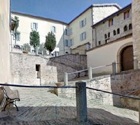

The original palaces were built next to the present Duomo soon after its completion in ca. 1188. In a document of this period, Bishop Bentivoglio conceded to the canons the site “in quo constructum est” (on which was already constructed) the new church of SS Mariano e Ubaldo and the episcopal palace (Palazzo Vescovile). This site was used for a new palace for the canons of the Duomo (Palazzo dei Canonici).
Palazzo dei Canonici (early 13th century)
This palace, which was built to house the College of Canons of the Duomo, was extended over the period when the college was closed in ca. 1520. The palace now houses the Museo Diocesano.
[Three bifores on the facade. ]
The upper part of the building was lowered in the 17th century.
Cloister?
It is possible to recognise
-
✴the kitchen (Room I of the Museo Diocesano);
-
✴the refectory, which still contains the original sink , three grandiose mullioned windows and a small pulpit (Room V of the Museo Diocesano); and
-
✴the Chapter Room.
The cellar, with the huge Botte Grande (15th century) is visible through one of the open arches in the wall. This barrel holds 387 Gubbian barrels of wine, each of which is the equivalent of 50 litres. It is built without metal rings, and stands in a chamber that was specially adapted to support it.
Palazzo Vescovile (18th century)

The palace owes its present appearance to its restructuring by Bishop Sostegno Maria Cavalli (1725-47). It now houses the episcopal residence, the diocesan offices and archives, and the Biblioteca Fonti.
Excavations here that were carried out in 1979-82 uncovered at the lower level ceramic and other material that suggested the presence of habitation in the late Bronze Age and early Iron Age.

